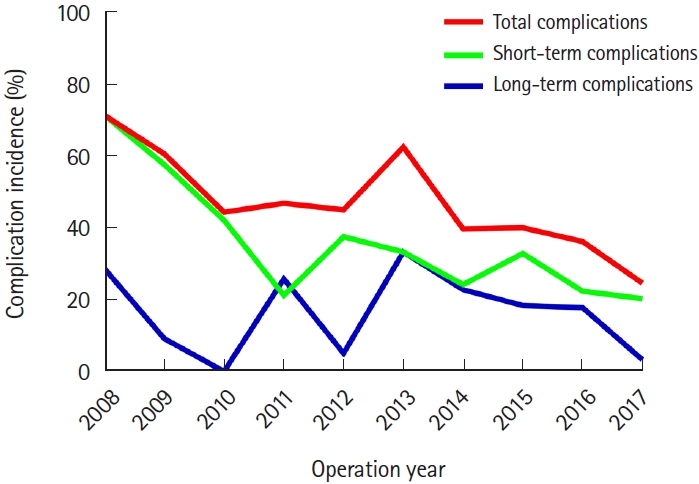 |
 |
- Search
| Intest Res > Volume 21(2); 2023 > Article |
|
Abstract
Background/Aims
Methods
Results
ADDITIONAL INFORMATION
Funding Source
This work was supported by National Natural Science Foundation (grant number 81800484), Science & Technology Planning Project of Guangdong Province (grant numbers 20160916, 2015B020229001) and National Key Clinical Discipline in general surgery.
Author Contributions
Conceptualization: Cai Z, He Z, Lan P, Wu X. Data curation: Cai Z, He X, Gong J, Du P, Meng W, Zhou W, Jiang J, Wu B, Yuan W, Xue Q, Yuan L, Wang J, Tai J, Liang J, Zhu W. Funding acquisition: Cai Z, Lan P, Wu X. Investigation: Cai Z, He X. Methodology: Cai Z, He X. Writing - original draft: Cai Z. Writing - review & editing: all authors. Approval of final manuscript: all authors.
Additional Contributions
Collaborative IBD centers are as follows: Jinling Hospital (Nanjing University), Xinhua Hospital (Shanghai Jiao Tong University), West China Hospital (Sichuan University), the Sixth Affiliated Hospital (Sun Yat-sen University), Sir Run Run Shaw Hospital (Zhejiang University), the First Affiliated Hospital (Zhejiang University), Qilu Hospital (Shandong University), Peking Union Medical College Hospital, the First Affiliated Hospital (Zhengzhou University), Nanfang Hospital (Southern Medical University), the Second Xiangya Hospital (Central South University), First Hospital (Jilin University), and Xijing Hospital (Fourth Military Medical University).
We thank Lei Lian, Xianrui Wu, Bin Zheng, Xuanhui Liu, Xuming Huang, Wenyu Li, Xiaoling Li, and Futian Luo for their assistance in the study.
Supplementary Material
Fig.┬Ā1.

Table┬Ā1.
| Complications | Total (n = 446) | 2008-2013 group (n = 144) | 2014-2017 group (n = 302) | P-value |
|---|---|---|---|---|
| Short-term complications | 134 (30.0) | 59 (41.0) | 75 (24.8) | 0.001 |
| ŌĆāInfectious complications | 66 (14.8) | 32 (22.2) | 34 (11.3) | 0.002 |
| ŌĆāŌĆāAbdominal infection | 38 (8.5) | 21 (14.6) | 17 (5.6) | 0.002 |
| ŌĆāŌĆāPulmonary infection | 25 (5.6) | 10 (6.9) | 15 (5.0) | 0.400 |
| ŌĆāŌĆāUrinary infection | 14 (3.1) | 8 (5.6) | 6 (2.0) | 0.040 |
| ŌĆāNoninfectious complications | 102 (22.9) | 43 (29.9) | 59 (19.5) | 0.015 |
| ŌĆāŌĆāAnastomotic leakage | 13 (2.9) | 9 (6.3) | 4 (1.3) | 0.004 |
| ŌĆāŌĆāIleus | 42 (9.4) | 22 (15.3) | 20 (6.6) | 0.003 |
| ŌĆāŌĆāIntra-abdominal hemorrhage | 23 (5.2) | 8 (5.6) | 15 (5.0) | 0.790 |
| ŌĆāŌĆāAnastomotic hemorrhage | 15 (3.4) | 7 (4.9) | 8 (2.6) | 0.230 |
| ŌĆāŌĆāUrinary retention | 13 (2.9) | 4 (2.8) | 9 (3.0) | 0.910 |
| ŌĆāŌĆāEnteritis | 7 (1.6) | 1 (0.7) | 6 (2.0) | 0.310 |
| Long-term complicationsa | 66 (15.8) | 21 (15.8) | 45 (15.8) | 0.990 |
| ŌĆāInfectious complications | 13 (3.1) | 6 (4.5) | 7 (2.5) | 0.260 |
| ŌĆāŌĆāAbdominal infection | 5 (1.2) | 3 (2.3) | 2 (0.7) | 0.330 |
| ŌĆāŌĆāUrinary infection | 4 (1.0) | 0 | 4 (1.4) | 0.310 |
| ŌĆāNoninfectious complications | 49 (11.8) | 19 (14.3) | 30 (10.6) | 0.270 |
| ŌĆāŌĆāEnteral fistula | 11 (2.6) | 5 (3.8) | 6 (2.1) | 0.340 |
| ŌĆāŌĆāPouchitis | 28 (6.7) | 12 (9.0) | 16 (5.6) | 0.200 |
| ŌĆāŌĆāAnastomotic stricture | 14 (3.4) | 3 (2.3) | 11 (3.9) | 0.560 |
| ŌĆāŌĆāIleus | 13 (3.1) | 5 (3.8) | 8 (2.8) | 0.560 |








